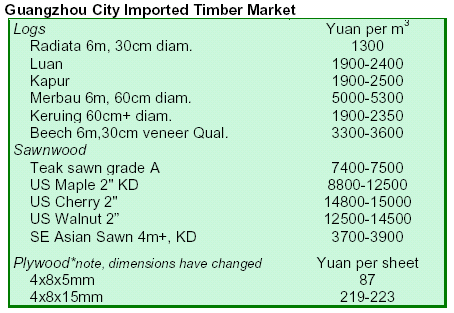|
US
Dollar Exchange Rates of 15th Feb. 2008
China Yuan
7.112
Report from China
EU drops anti-dumping review of Chinese plywood
Xinhua News reported on the European Commission¡¯s
announcement to terminate its partial interim review of
anti-dumping measures against imports of okoume
plywood from China. The EC found that termination of
the review would not be against the EU¡¯s interests. The
Commission said the decision to terminate the review was
taken after the European Federation of the Plywood
Industry withdrew its request for review in December
2007, which was intended to extend the existing antidumping
measures to more types of Chinese plywood
products. The EU imposed a definitive anti-dumping duty
on imports of Chinese okoume plywood in 2004, imposing
fees ranging from 6.5 to 66.7%. The Commission said
that although the review to extend anti-dumping duties
was terminated, the existing anti-dumping measures would
still remain in force.
Blizzard conditions cripple Chinese forestry industry
Catastrophic blizzard and icy rains, which covered half of
China in mid-January, have caused great losses for
China¡¯s forest industry. According to the latest statistics
from 19 provinces, autonomous regions and
municipalities, 186 million ha (279 million mu), 1,781
state-owned forest farms and 1,200 nurseries were
negatively affected by the weather. About 760 tons of tree
seeds and 10 billion seedlings were frozen and 30,000
animals and other wildlife in protected areas were found
injured or dead. The direct economic losses to the forestry
sector amounted to RMB57.3 billion yuan with 2.6 million
forestry staff, other forest farmers and people in Hunan
Province severely affected. Due to the recent low
temperature, it will take some time before the snow melts,
causing further losses to the industry. The disaster has four
main impacts:
(1) Forest losses accounted for a high proportion of total
economic losses. According to a survey from eight
provinces, forest losses accounted for 40-60% of the
disaster losses in each province. The direct forest
economic losses in Jiangxi Province alone amounted to
about RMB11.27 billion yuan, accounting for 41% of the
total RMB27.3 billion yuan of economic losses. Forest
losses in Guilin of Guangxi Province and Qiandongnon
prefecture in Guizhou Province accounted for over 60% of
local disaster losses.
(2) Seedlings, bamboo forest and newly planted forests
were severely impacted by the blizzards, causing a high
mortality rate in seedlings. In Hubei Province, about 2.59
million ha (3.88 million mu), or around 80% of the total
bamboo forest area, was affected. About 75% of seedlings,
bamboo and new forests in regions of Danjiang Reservoir,
Fushui Reservoirs and the Three Gorges Reservoir were
also impacted.
(3) Economic losses for farmers were also high. Forests
established as investments for state and local people
suffered heavy losses. Over 80% of the collective-owned
plantations of Moso Bamboo, Slash Pine and Oil tea
Camellia suffered the most serious effects of the blizzards.
(4) Finally, the calamities are expected to cause secondary
disasters. Due to the icy conditions and snow, there is a
greater chance of landslides, mud-rock flow, forest fires,
forest pests and disease.
The disaster is expected to impact overall demand and
supply of forest products. There is expected to be a sharp
decrease in supply of timber, bamboo, resin and camellia
oil. This is likely to heighten the gap between timber
demand and supply and dampen the overall operation of
forest enterprises, thus impacting the employment of
millions of people as well as the demand and supply of
forest products over the next few years.
Exports through Guangdong Port rise 34% in 2007
Furniture exports through Guangdong Port in 2007 rose
34% to USD9.3 billion, 40% of the national total.
Furniture exports through Guangdong are generally
exported to the US and the EU, which receive 60% of the
total furniture exports from Guangdong. Furniture
exporting enterprises are looking for new opportunities in
ASEAN markets. Furniture exports to ASEAN markets
have increased 120% to USD120 million in 2007.
China Customs has reported that foreign capital furniture
enterprises make up 50% of furniture enterprises in
Guangdong. However, private enterprises have developed
rapidly, with the furniture export value of private
enterprises rising 52% to USD2.58 billion in 2007.
Although furniture exports have been growing, furniture
production and processing enterprises have faced pressure
as a result of national policies established in 2007. One
was the tax rebate policy, under which tax rebates for
furniture being were reduced from 13 to 9% and wood
products to 5%. The other was a change brought about by
the Chinese government to revise a catalogue of prohibited
commodities in the processing trade to include 17 kinds of
furniture such as bedroom furniture of lacquered wood and
other furniture of rosewood.
Henglin Coutry Flooring Industry ranks first in China
Henglin County has been a leader in China¡¯s flooring
industry, as its output of impregnated paper laminated
floors makes up 45% of the national total. The county,
which is located in Changzhou City of Jiangsu Province,
produced 160 million m2 of flooring, of which 77.3
million m2 was exported. The county was responsible for
50% of the national exports of impregnated paper
laminated floors.
Over 400 impregnated paper laminated flooring
production and supporting enterprises have been
established in the county since the first impregnated paper
laminated flooring enterprises opened in October 1999.
The county has become known as the main production and
distribution base for the flooring. Heglin County¡¯s outputs
will also expand after the Henglin International Flooring
City opens its operations.

 ¡¡ ¡¡
|